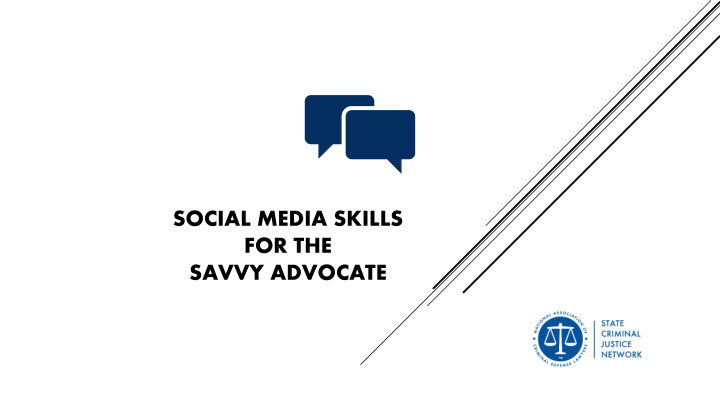



SOCIAL MEDIA SKILLS FOR THE SAVVY ADVOCATE
BENEFITS OF SOCIAL MEDIA USE FOR ADVOCACY Provides a massive platform for • networking Provides a cost-effective way to • connect with others to promote a common cause Offers efficient resources to inform • and collect support from the community Connects you with journalists, • lawmakers, and other advocates
BUILDING AN ONLINE ADVOCACY COALITION Who am I trying to reach? How do I reach them? How do I leverage analytics to maximize results?
IDENTIFY LIKE-MINDED ORGANIZATIONS
CREATE A FOLLOWING • Following other like-minded organization is the fastest and most efficient way to assure others follow you back and, in turn, increase your following. • Exposure to a diverse coalition of ideas helps generate social media strategies that can be tailored to fit your advocacy goals. • Engaging as many followers as possible is crucial to increasing the overall reach and influence of your message as well as facilitating partnerships with other organizations.
CASE STUDY NACDL’s most popular posts can be • attributed to “tagging.” Success in social media advocacy • relies on generating likes/retweets from other followers and creating an exponentially larger audience. Example: NACDL tweets a story to 11k • followers. The Appeal retweets NACDL to their 90k followers. The author then retweets NACDL, expanding the reach to their followers, and so on. A post with an initial reach of 11k can • easily turn into a reach of 100k – 1m users depending on who shares it. Social media engagement helps • expand the overall reach of your message, attracts potential new followers, and encourages quid pro quo exposure and outreach.
CHOOSING A PLATFORM TO BEST SUIT YOUR NEEDS Advocacy orgs use a variety of social media, but Facebook and Twitter dominate: Keep it short: Facebook posts of up to just 40 characters — a few • words, or a short sentence at most — generate the highest engagement. Make it visual: Photos/images are overwhelmingly the most engaging • type of content on Facebook, generating 87 percent interaction rate from page followers. Avoid text-only posts. Create a Following. Every time an individual shares, likes, or comments • on your Facebook posts, your page is made visible to that individual’s own Facebook friends, creating exponential reach. Promote events and push traffic to your website: Encourage users to • learn more about your organization’s work and to how to get involved. This includes keeping your website up to date.
CHOOSING A PLATFORM TO BEST SUIT YOUR NEEDS Advocacy orgs use a variety of social media, but Facebook and Twitter dominate: Use hashtags. Avoid creating your own hashtags, do research to • identify popular hashtags related to your mission. Tweet regularly. Don’t be inactive! When trying to build followers, • aim to tweet at least once a day. No more than once per hour. Make it visual: Try to attach an image to a tweet whenever • possible. Perform direct outreach: When you follow an account, that user will • receive a notification and potentially follow you back (e.g., elected officials, journalists, and local community groups). Tag whenever possible. Spread the word: Just like Facebook, you always want to direct • users to visit content on your own website or content that promotes your advocacy.
Different social media platforms have vastly different demographics: • Twitter users tend to be younger than Facebook users. • Instagram/Pinterest users overwhelmingly tend to be women. • Decide which platforms to use by thinking about the specific objectives and intended audiences for each of your campaigns.
General Tips for Using Social Media: Message Stay focused: The people and • organizations that follow you on social media have certain Target expectations about the type of Audience content you post and the way you engage with them. Take Action Be reliable: Share quality content • from trusted sources. Frequently sharing reliable content helps establish you as an important source of information. Image Be social: Social media is about • connecting people. The more you engage with your followers, the more they will understand where your priorities align. Keep it simple •
UTILIZING SOCIAL MEDIA ANALYTICS Be a detective: What posts are getting the • most likes/retweets/comments? What types of followers are • engaging with your content? What time slots works best? • Be aware of different time • zones when targeting audience across the country.
QUESTIONS?
Recommend
More recommend